Maximization of the Power Production of an Offshore Wind Farm
Abstract
:1. Introduction
2. Wind Farm Modeling
2.1. Wind Farm Simulator
2.2. Two-Turbine Wind Farm
2.3. Real-Life Offshore Wind Farm
3. Wind Farm Controller
3.1. Wake Control Strategy
3.1.1. Axial Induction Control
3.1.2. Wake Redirection Control
3.2. Power Production Optimizer
4. Simulation Results and Discussion
4.1. Two-Turbine Case
4.2. Offshore Wind Farm Case
5. Conclusions and Future Work
Author Contributions
Funding
Institutional Review Board Statement
Informed Consent Statement
Data Availability Statement
Conflicts of Interest
References
- Porté-Agel, F.; Bastankhah, M.; Shamsoddin, S. Wind-turbine and wind-farm flows: A review. Bound.-Layer Meteorol. 2020, 174, 1–59. [Google Scholar] [CrossRef] [PubMed] [Green Version]
- Scholbrock, A.K. Optimizing Wind Farm Control Strategies to Minimize Wake Loss Effects; University of Colorado at Boulder: Boulder, CO, USA, 2011. [Google Scholar]
- Sanderse, B. Aerodynamics of Wind Turbine Wakes-Literature Review; Technical Report; Energy Research Centre of the Netherlands: Amsterdam, The Netherlands, 2009. [Google Scholar]
- Rott, A.; Doekemeijer, B.; Seifert, J.K.; van Wingerden, J.W.; Kühn, M. Robust active wake control in consideration of wind direction variability and uncertainty. Wind Energy Sci. 2018, 3, 869–882. [Google Scholar] [CrossRef] [Green Version]
- Knudsen, T.; Bak, T.; Svenstrup, M. Survey of wind farm control—Power and fatigue optimization. Wind Energy 2015, 18, 1333–1351. [Google Scholar] [CrossRef]
- Kheirabadi, A.C.; Nagamune, R. A quantitative review of wind farm control with the objective of wind farm power maximization. J. Wind Eng. Ind. Aerodyn. 2019, 192, 45–73. [Google Scholar] [CrossRef]
- Kazda, J.; Mirzaei, M.; Cutululis, N.A. On the architecture of wind turbine control required for induction-based optimal wind farm control. In Proceedings of the 2018 Annual American Control Conference (ACC), Milwaukee, WI, USA, 27–29 June 2018; pp. 3074–3079. [Google Scholar]
- Kim, H.; Kim, K.; Paek, I. Model based open-loop wind farm control using active power for power increase and load reduction. Appl. Sci. 2017, 7, 1068. [Google Scholar] [CrossRef] [Green Version]
- Johnson, K.E.; Thomas, N. Wind farm control: Addressing the aerodynamic interaction among wind turbines. In Proceedings of the 2009 American Control Conference, St. Louis, MO, USA, 10–12 June 2009; pp. 2104–2109. [Google Scholar]
- Munters, W.; Meyers, J. Dynamic strategies for yaw and induction control of wind farms based on large-eddy simulation and optimization. Energies 2018, 11, 177. [Google Scholar] [CrossRef] [Green Version]
- Bastankhah, M.; Porté-Agel, F. Wind farm power optimization via yaw angle control: A wind tunnel study. J. Renew. Sustain. Energy 2019, 11, 023301. [Google Scholar] [CrossRef] [Green Version]
- Fleming, P.; King, J.; Dykes, K.; Simley, E.; Roadman, J.; Scholbrock, A.; Murphy, P.; Lundquist, J.K.; Moriarty, P.; Fleming, K.; et al. Initial results from a field campaign of wake steering applied at a commercial wind farm—Part 1. Wind Energy Sci. 2019, 4, 273–285. [Google Scholar] [CrossRef] [Green Version]
- Fleming, P.; King, J.; Simley, E.; Roadman, J.; Scholbrock, A.; Murphy, P.; Lundquist, J.K.; Moriarty, P.; Fleming, K.; van Dam, J.; et al. Continued results from a field campaign of wake steering applied at a commercial wind farm—Part 2. Wind Energy Sci. 2020, 5, 945–958. [Google Scholar] [CrossRef]
- Shin, J.; Baek, S.; Rhee, Y. Wind Farm Layout Optimization Using a Metamodel and EA/PSO Algorithm in Korea Offshore. Energies 2021, 14, 146. [Google Scholar] [CrossRef]
- Asaah, P.; Hao, L.; Ji, J. Optimal Placement of Wind Turbines in Wind Farm Layout Using Particle Swarm Optimization. J. Mod. Power Syst. Clean Energy 2021, 9, 367–375. [Google Scholar] [CrossRef]
- Howland, M.F.; Lele, S.K.; Dabiri, J.O. Wind farm power optimization through wake steering. Proc. Natl. Acad. Sci. USA 2019, 116, 14495–14500. [Google Scholar] [CrossRef] [PubMed] [Green Version]
- Annoni, J.; Gebraad, P.M.; Scholbrock, A.K.; Fleming, P.A.; Wingerden, J.W.V. Analysis of axial-induction-based wind plant control using an engineering and a high-order wind plant model. Wind Energy 2016, 19, 1135–1150. [Google Scholar] [CrossRef]
- Van der Hoek, D.; Kanev, S.; Allin, J.; Bieniek, D.; Mittelmeier, N. Effects of axial induction control on wind farm energy production-a field test. Renew. Energy 2019, 140, 994–1003. [Google Scholar] [CrossRef]
- Bartl, J.; Sætran, L. Experimental testing of axial induction based control strategies for wake control and wind farm optimization. J. Phys. Conf. Ser. 2016, 753, 032035. [Google Scholar] [CrossRef]
- Gebraad, P.M.; Fleming, P.A.; van Wingerden, J.W. Comparison of actuation methods for wake control in wind plants. In Proceedings of the 2015 American Control Conference (ACC), Chicago, IL, USA, 1–3 July 2015; pp. 1695–1701. [Google Scholar]
- Hulsman, P.; Andersen, S.J.; Göçmen, T. Optimizing wind farm control through wake steering using surrogate models based on high-fidelity simulations. Wind Energy Sci. 2020, 5, 309–329. [Google Scholar] [CrossRef] [Green Version]
- Archer, C.L.; Vasel-Be-Hagh, A. Wake steering via yaw control in multi-turbine wind farms: Recommendations based on large-eddy simulation. Sustain. Energy Technol. Assess. 2019, 33, 34–43. [Google Scholar] [CrossRef]
- van Dijk, M.T.; van Wingerden, J.W.; Ashuri, T.; Li, Y.; Rotea, M.A. Yaw-misalignment and its impact on wind turbine loads and wind farm power output. J. Phys. Conf. Ser. 2016, 753, 062013. [Google Scholar] [CrossRef] [Green Version]
- Qian, G.W.; Ishihara, T. Wind farm power maximization through wake steering with a new multiple wake model for prediction of turbulence intensity. Energy 2021, 220, 119680. [Google Scholar] [CrossRef]
- Fleming, P.; Annoni, J.; Shah, J.J.; Wang, L.; Ananthan, S.; Zhang, Z.; Hutchings, K.; Wang, P.; Chen, W.; Chen, L. Field test of wake steering at an offshore wind farm. Wind Energy Sci. 2017, 2, 229–239. [Google Scholar] [CrossRef] [Green Version]
- Boersma, S.; Doekemeijer, B.; Vali, M.; Meyers, J.; van Wingerden, J.W. A control-oriented dynamic wind farm model: WFSim. Wind Energy Sci. 2018, 3, 75–95. [Google Scholar] [CrossRef] [Green Version]
- Ramírez Castillo, S.A. Engineering Models Enhancement for Wind Farm Wake Simulation and Optimization. Graduation Thesis, Polytechnic University of Milan (Politecnico di Milano), Milan, Italy, 2019. [Google Scholar]
- Boersma, S.; Gebraad, P.; Vali, M.; Doekemeijer, B.; Van Wingerden, J. A control-oriented dynamic wind farm flow model: “WFSim”. J. Phys. Conf. Ser. 2016, 753, 032005. [Google Scholar] [CrossRef]
- Frederik, J. Dynamic Wind Farm Control Using the WFSim Flow Model. Master’s Thesis, Delft Center for Systems and Control (DCSC), Delft University of Technology, Delft, The Netherlands, 2017. [Google Scholar]
- Meyers, J.; Meneveau, C. Large eddy simulations of large wind-turbine arrays in the atmospheric boundary layer. In Proceedings of the 48th AIAA Aerospace Sciences Meeting Including the New Horizons Forum and Aerospace Exposition, Orlando, FL, USA, 4–7 January 2010; p. 827. [Google Scholar]
- Global Wind Atlas. Available online: https://globalwindatlas.info/ (accessed on 15 October 2021).
- Adaramola, M.; Krogstad, P.Å. Experimental investigation of wake effects on wind turbine performance. Renew. Energy 2011, 36, 2078–2086. [Google Scholar] [CrossRef]
- Barthelmie, R.; Hansen, K.; Frandsen, S.; Rathmann, O.; Schepers, J.; Schlez, W.; Phillips, J.; Rados, K.; Zervos, A.; Politis, E.; et al. Modelling and Measuring Flow and Wind Turbine Wakes in Large Wind Farms Offshore. In Renewable Energy; Routledge: London, UK, 2018; pp. 251–267. [Google Scholar]
- Méchali, M.; Barthelmie, R.; Frandsen, S.; Jensen, L.; Réthoré, P.E. Wake effects at Horns Rev and their influence on energy production. In European Wind Energy Conference and Exhibition; Citeseer: Princeton, NJ, USA, 2006; Volume 1, pp. 10–20. [Google Scholar]
- Barthelmie, R.; Churchfield, M.J.; Moriarty, P.J.; Lundquist, J.K.; Oxley, G.; Hahn, S.; Pryor, S. The role of atmospheric stability/turbulence on wakes at the Egmond aan Zee offshore wind farm. J. Phys. Conf. Ser. 2015, 625, 012002. [Google Scholar] [CrossRef]



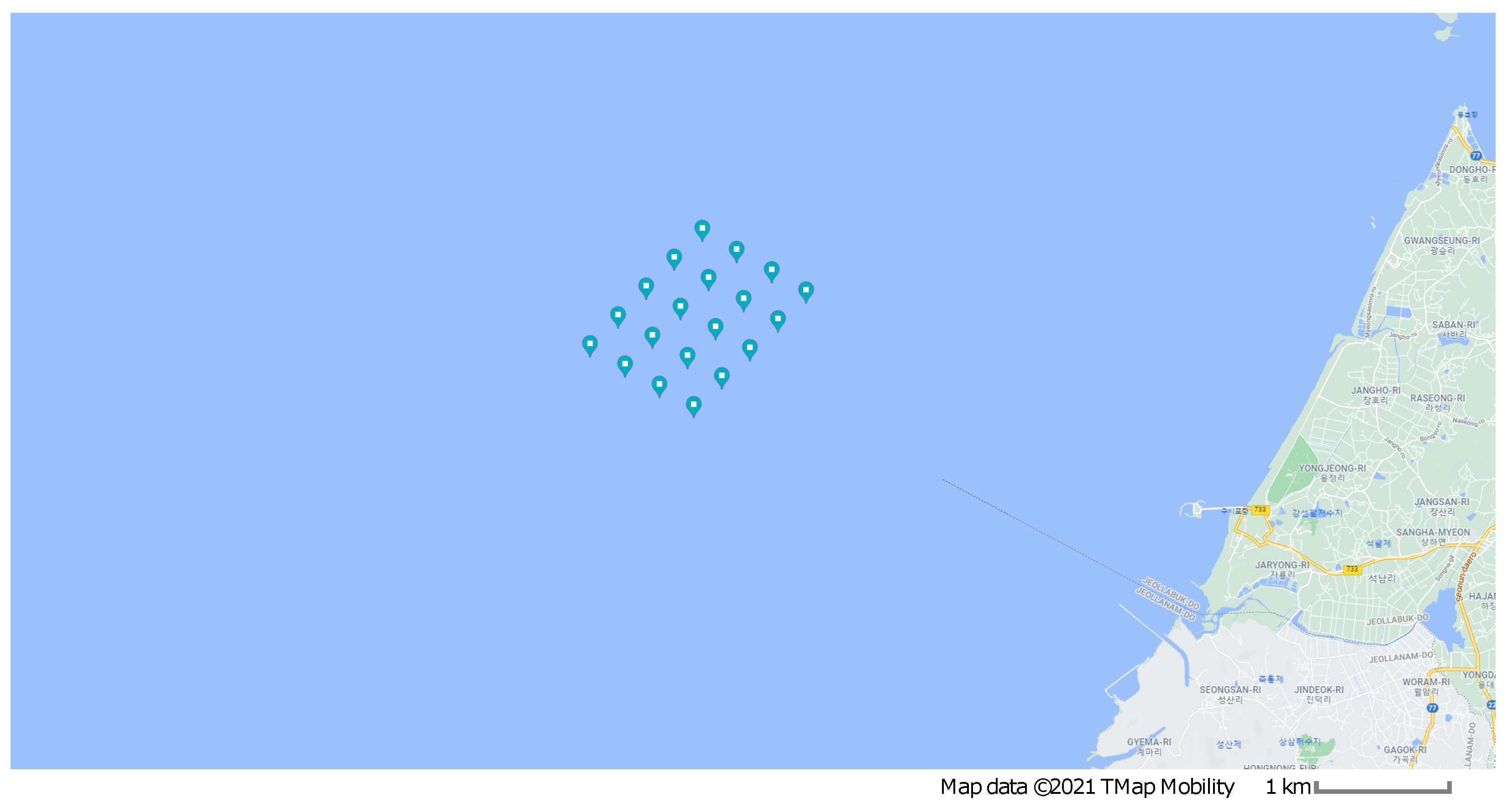
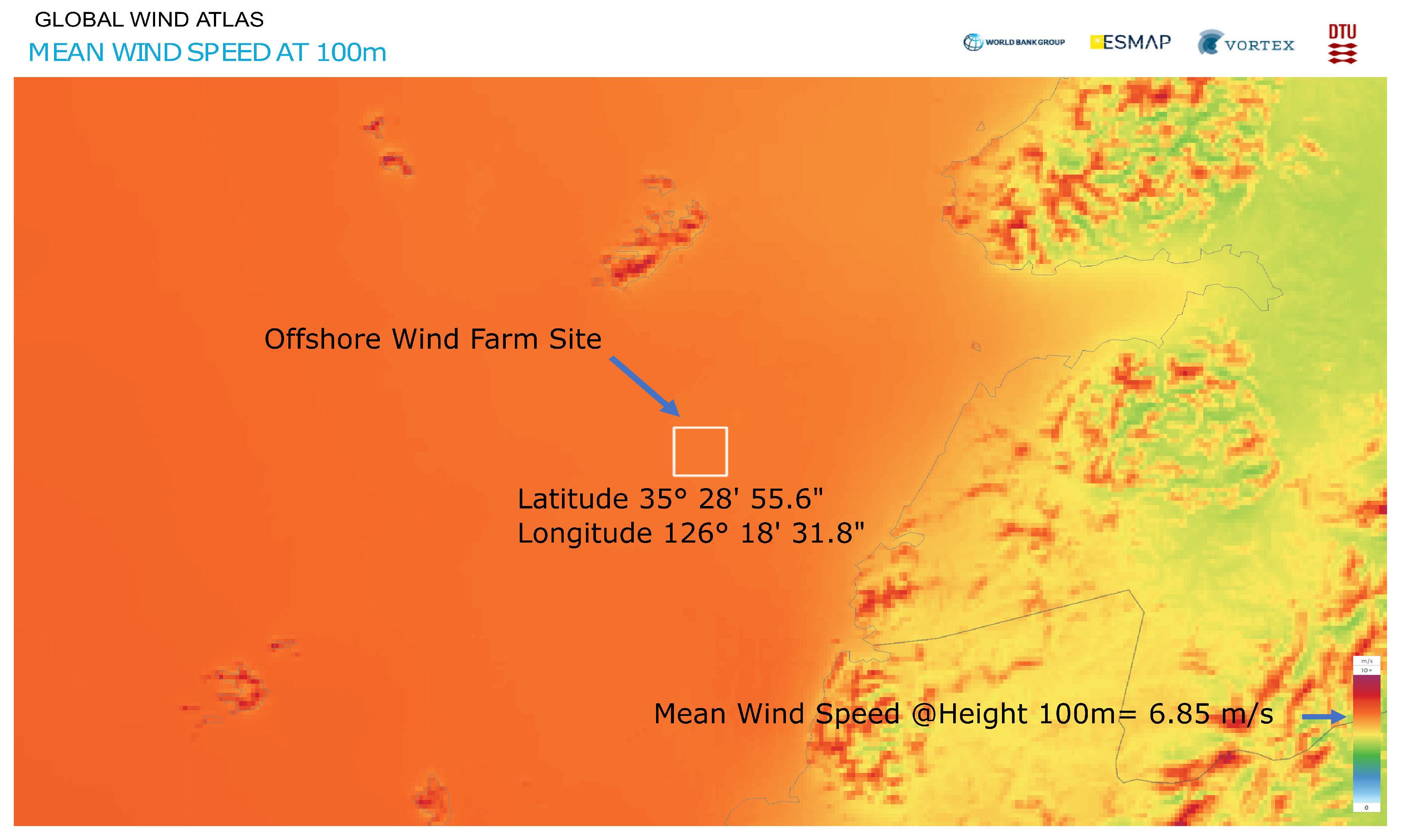

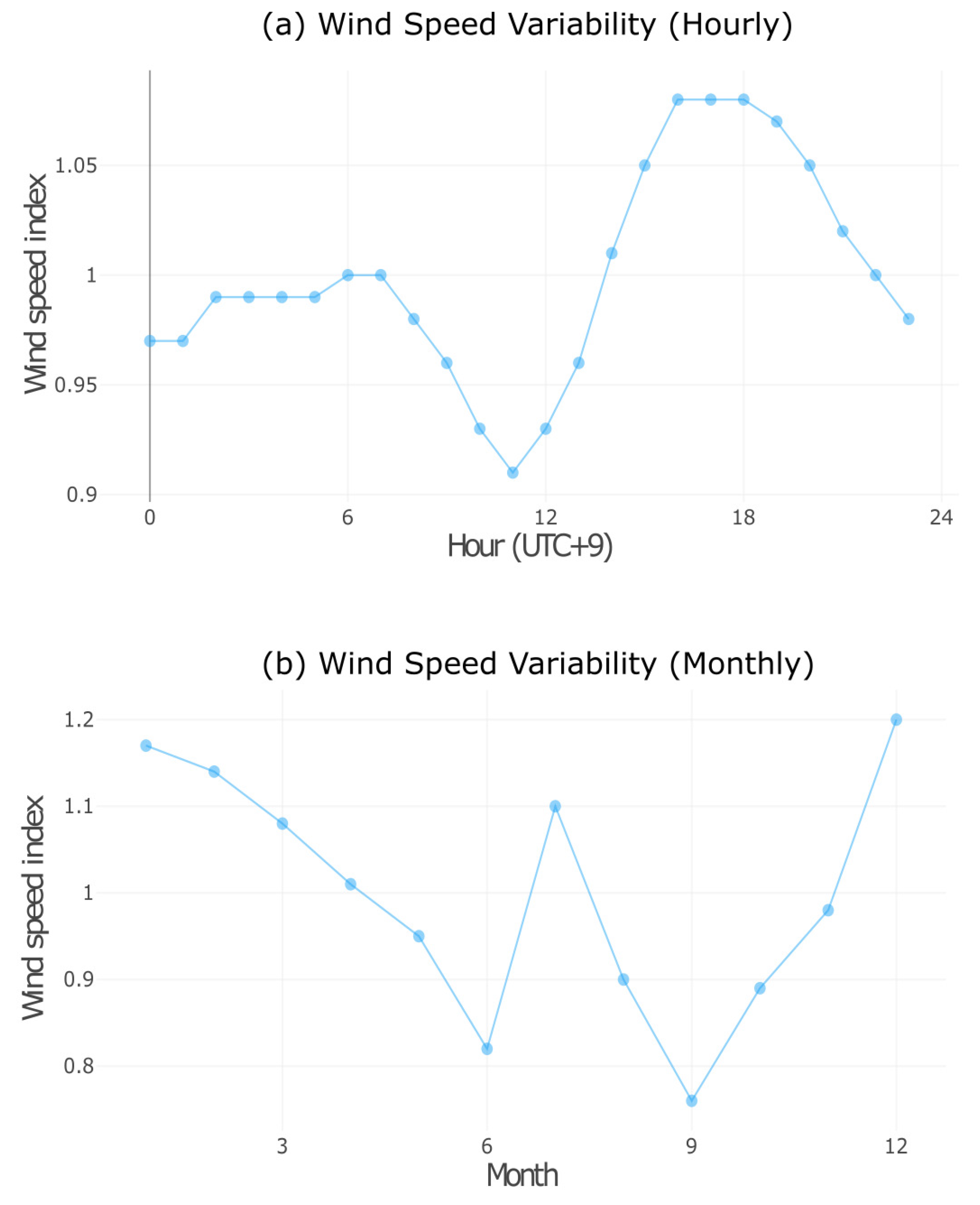
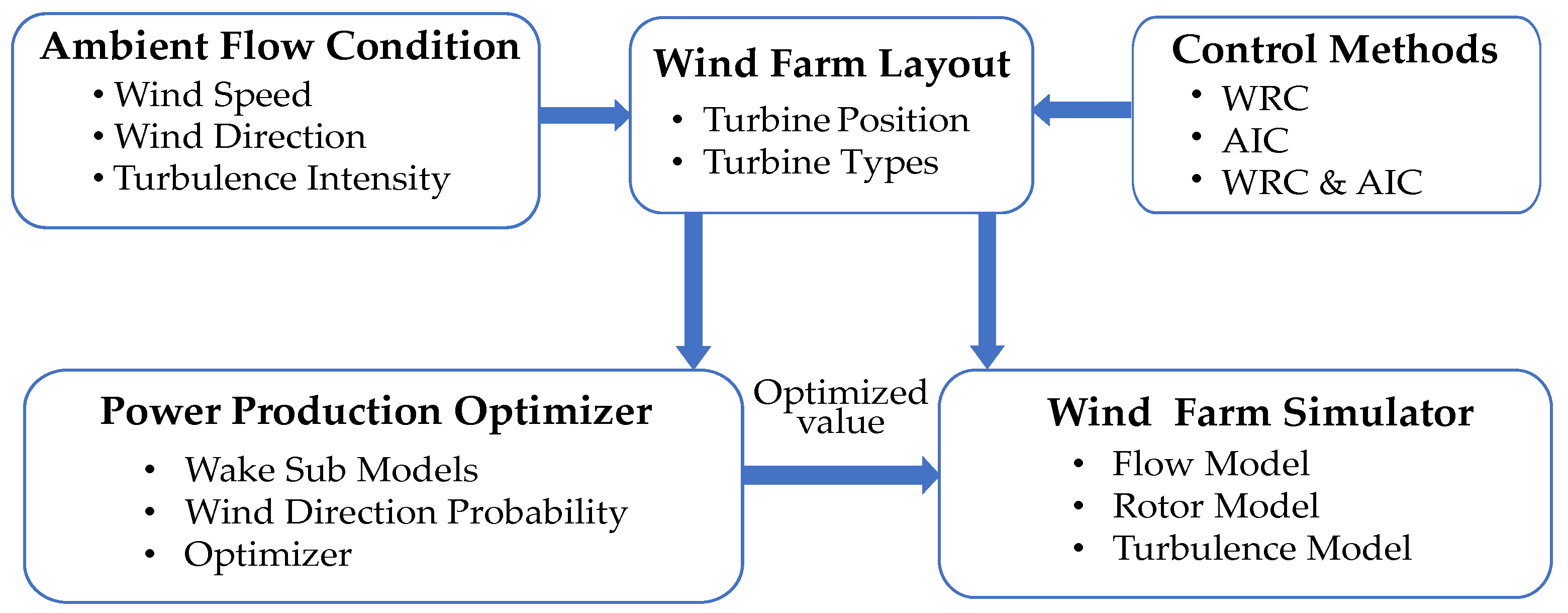
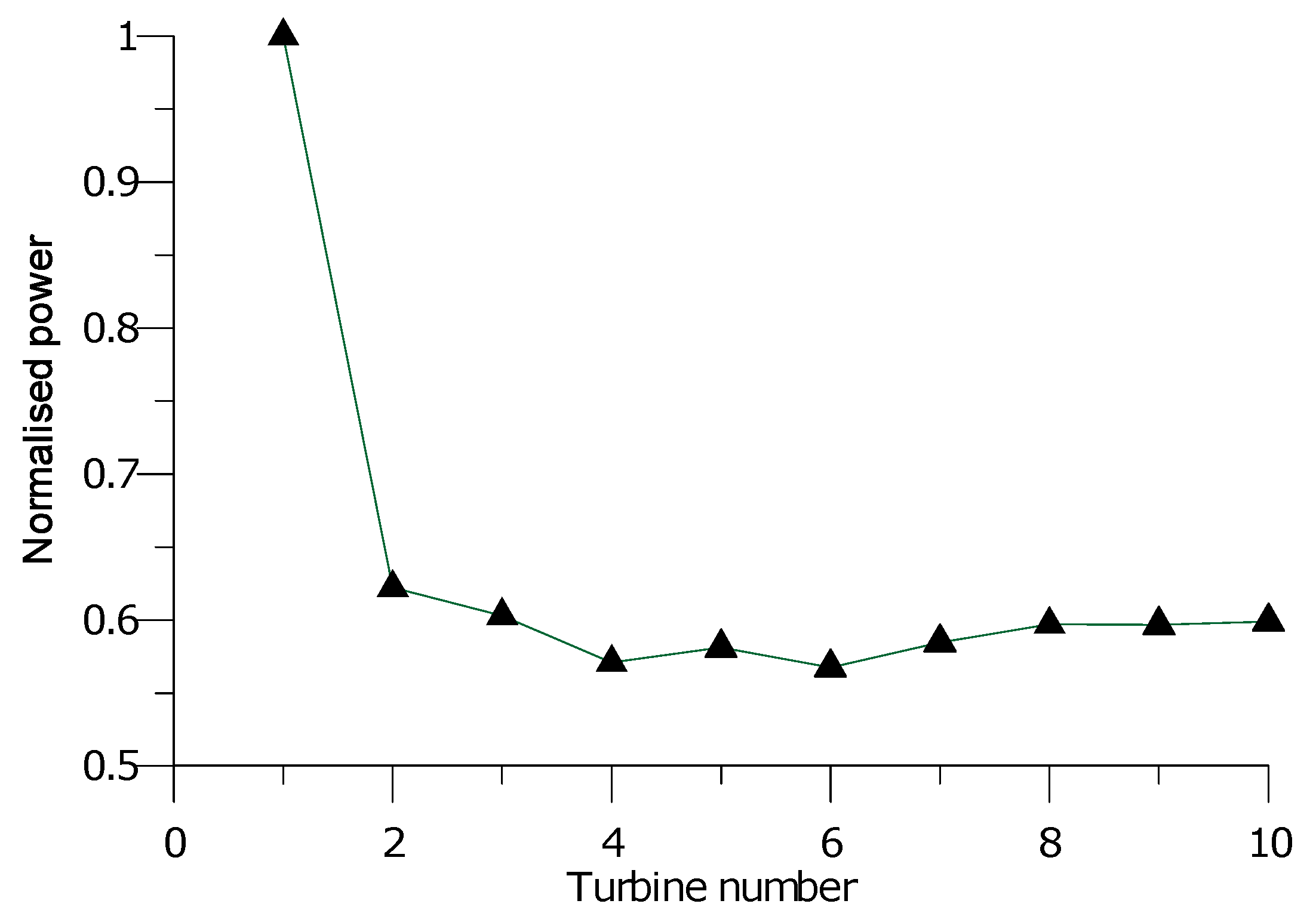
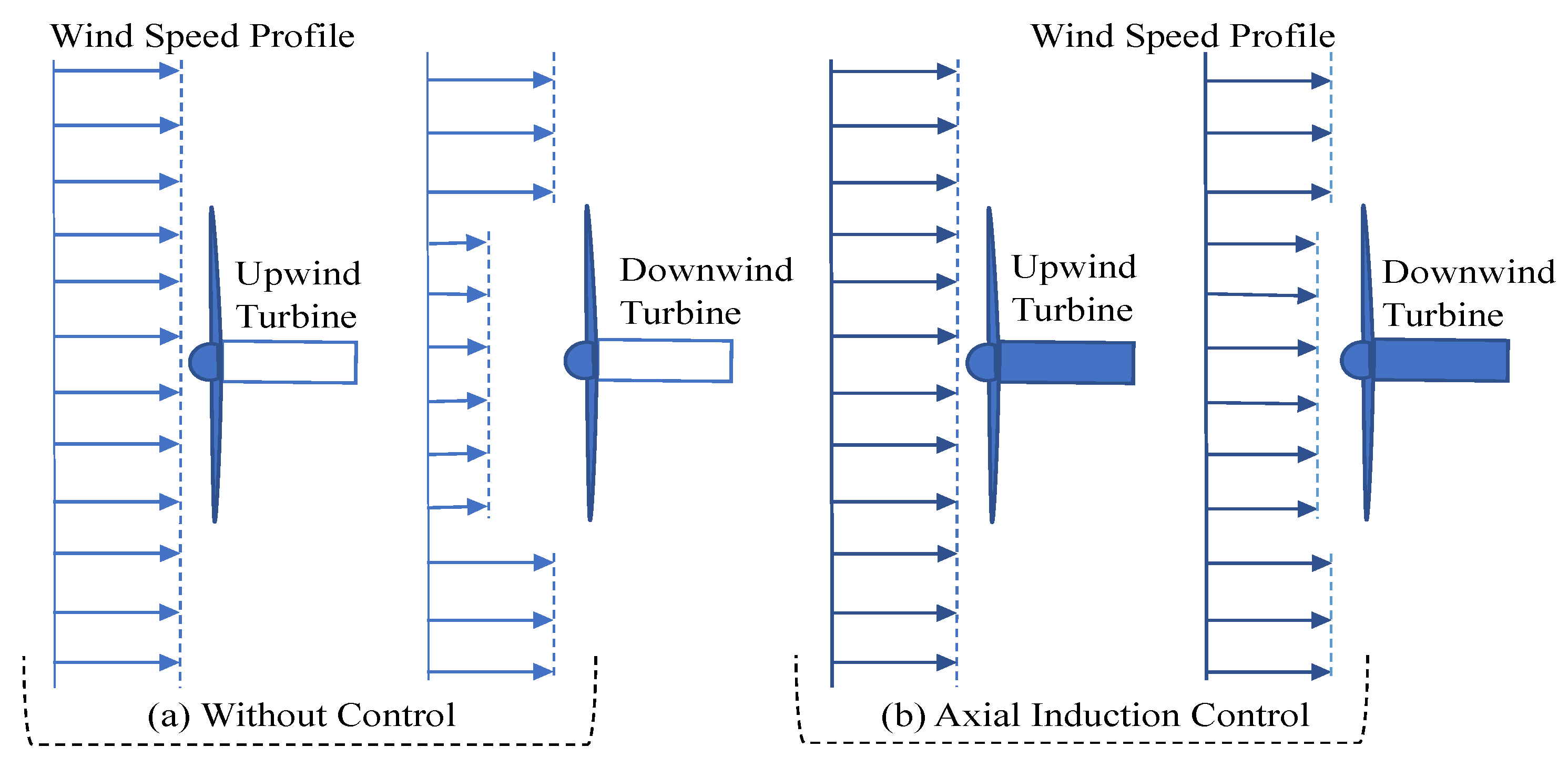
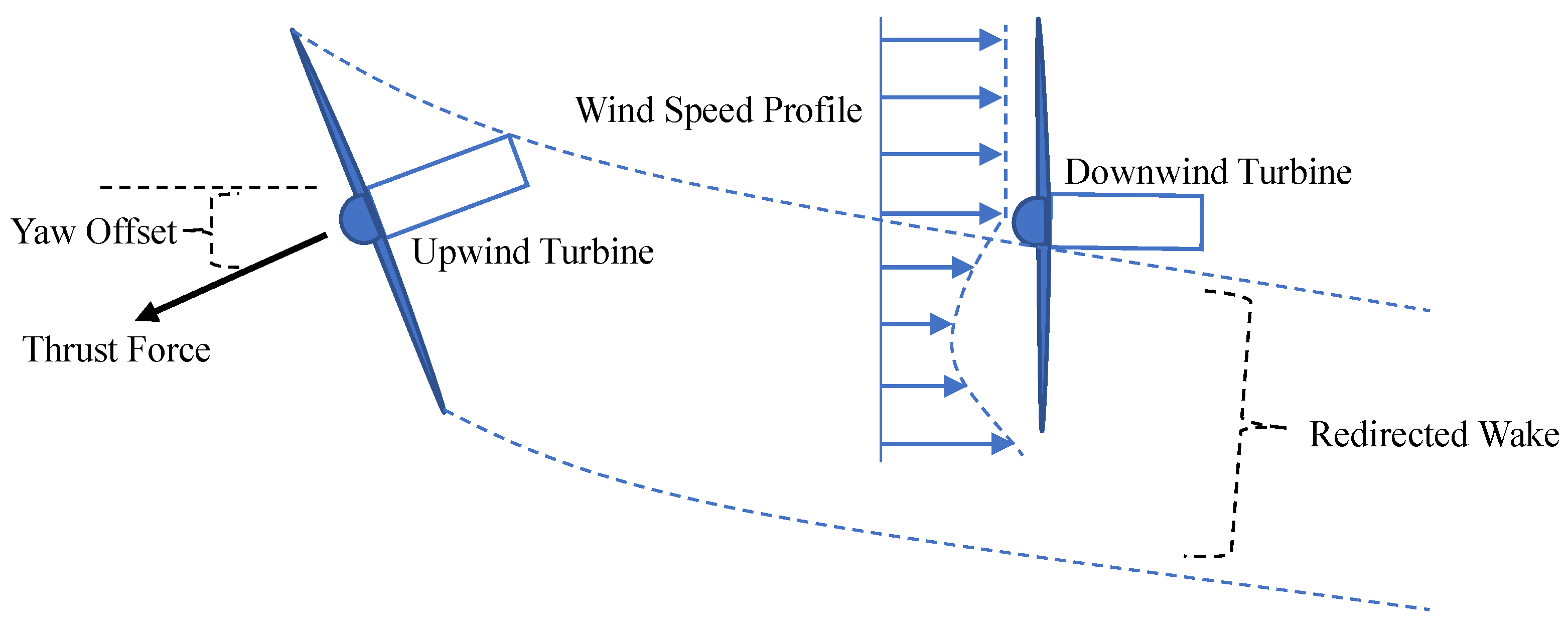
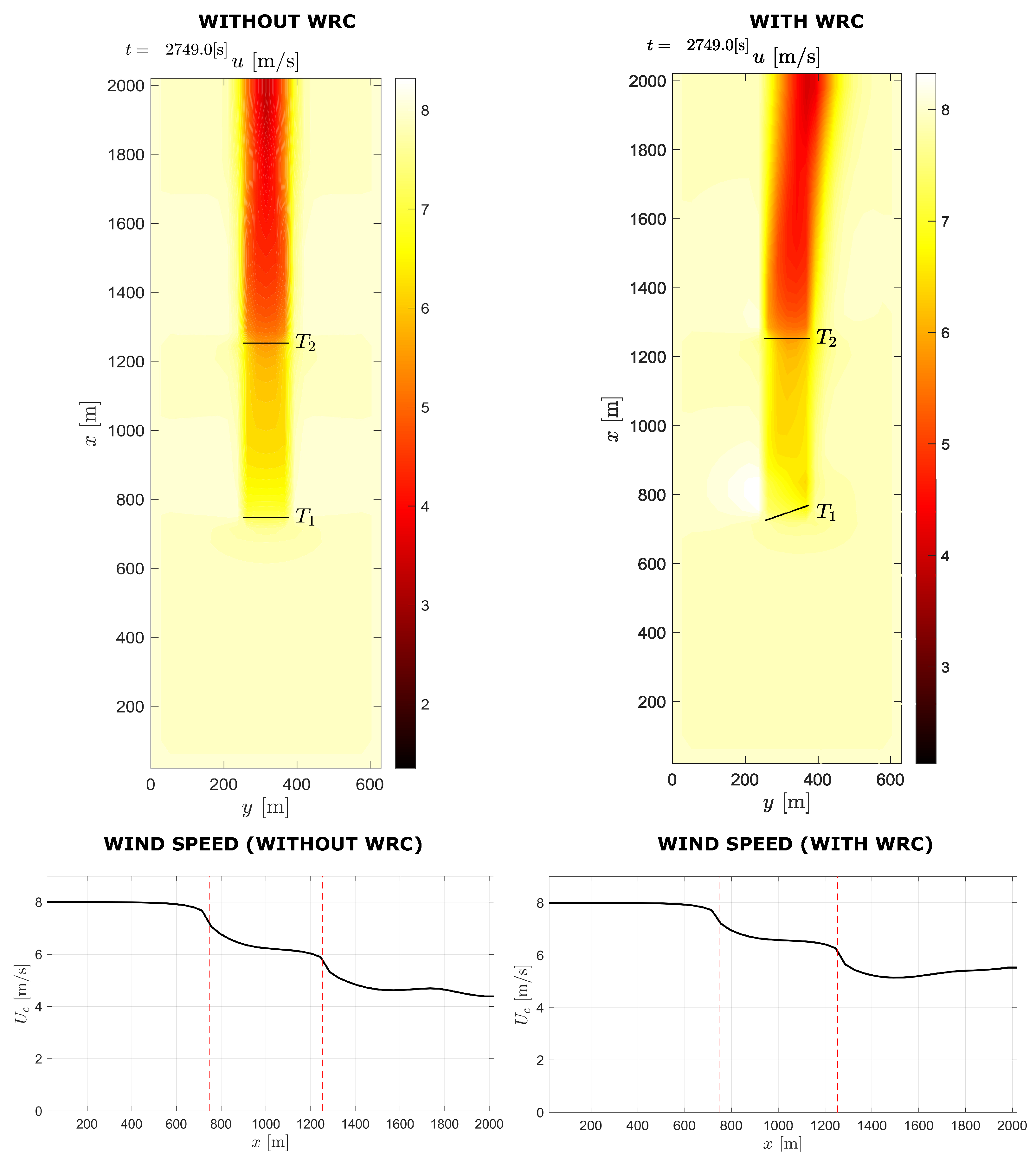
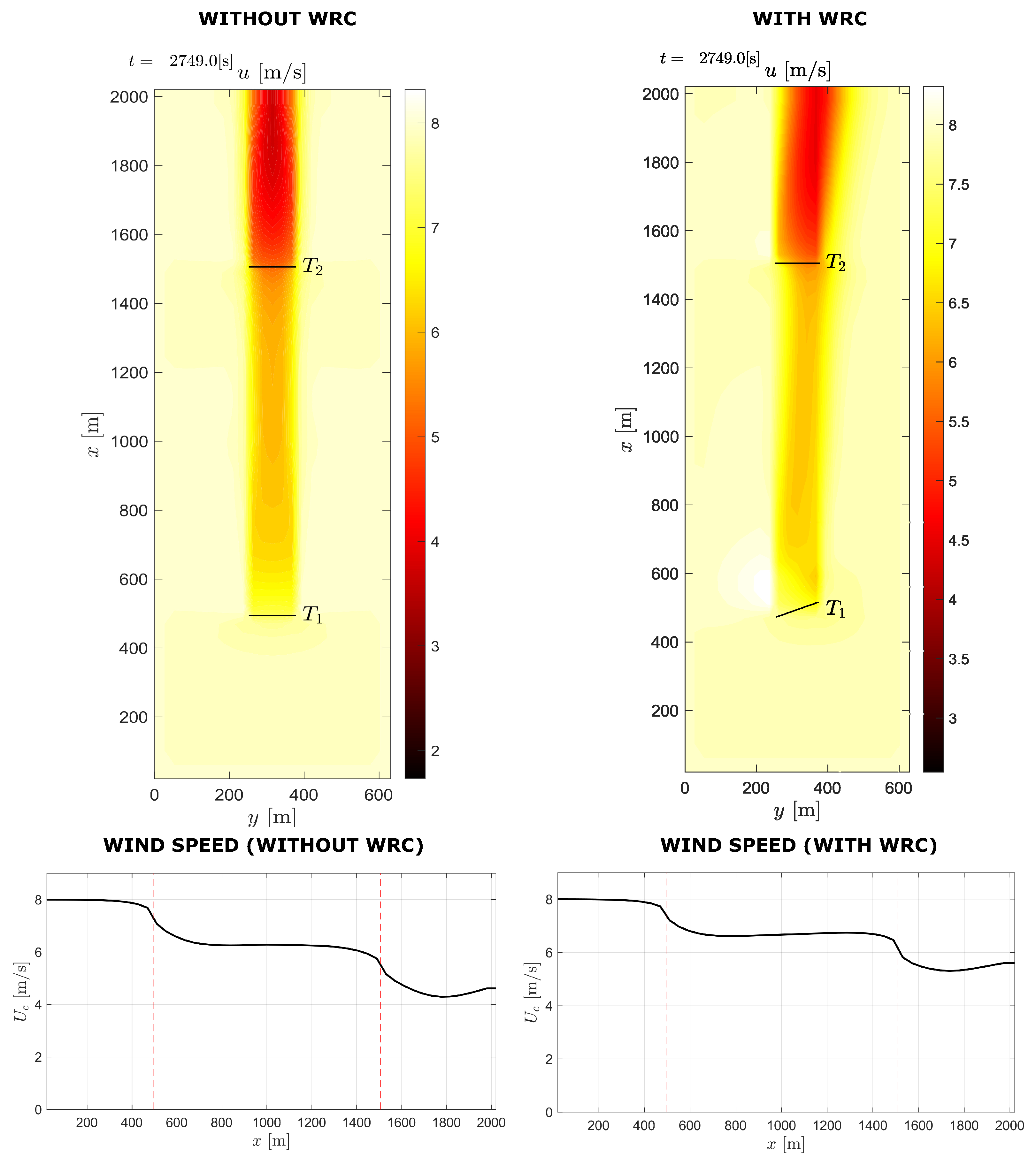

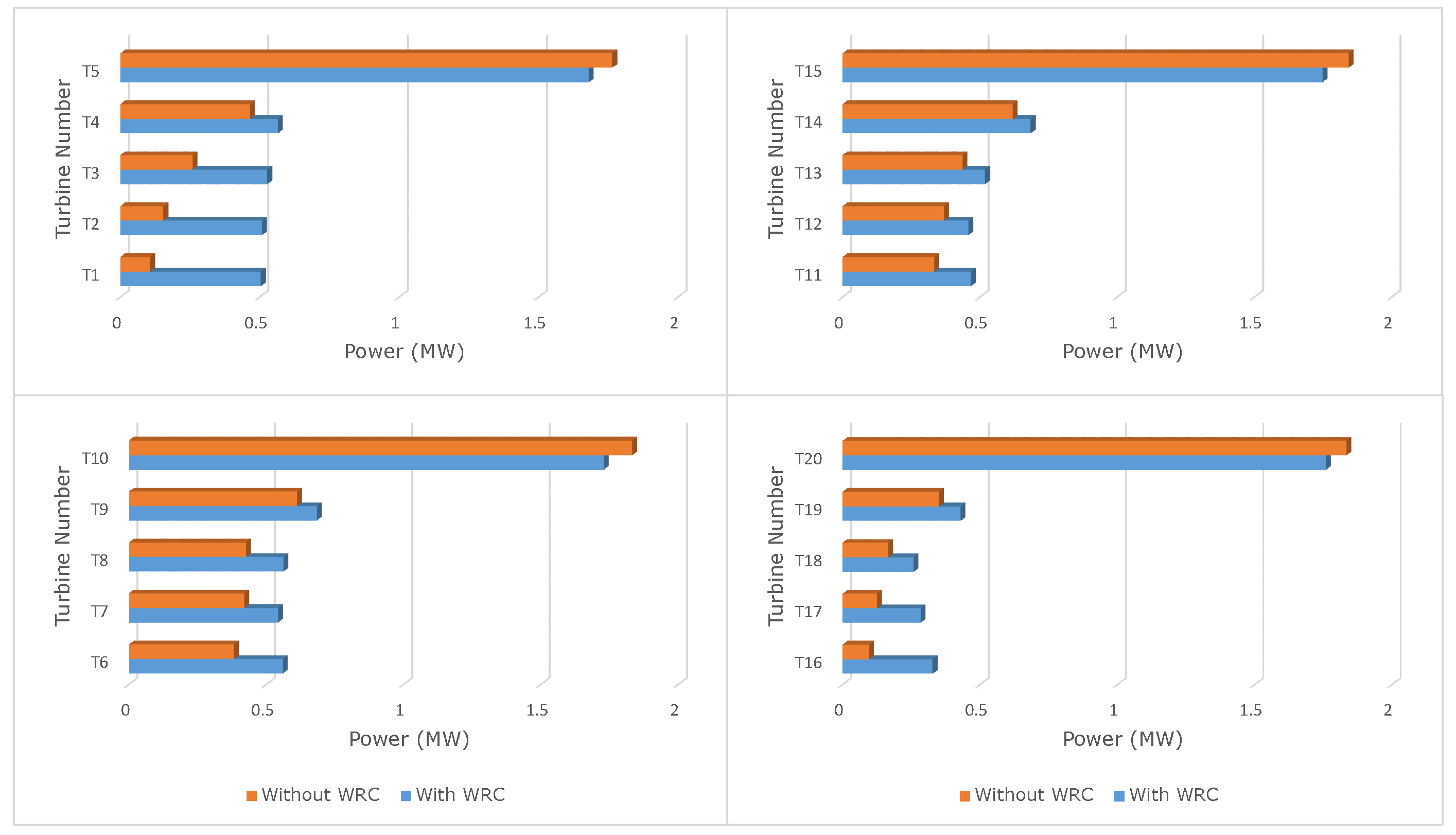
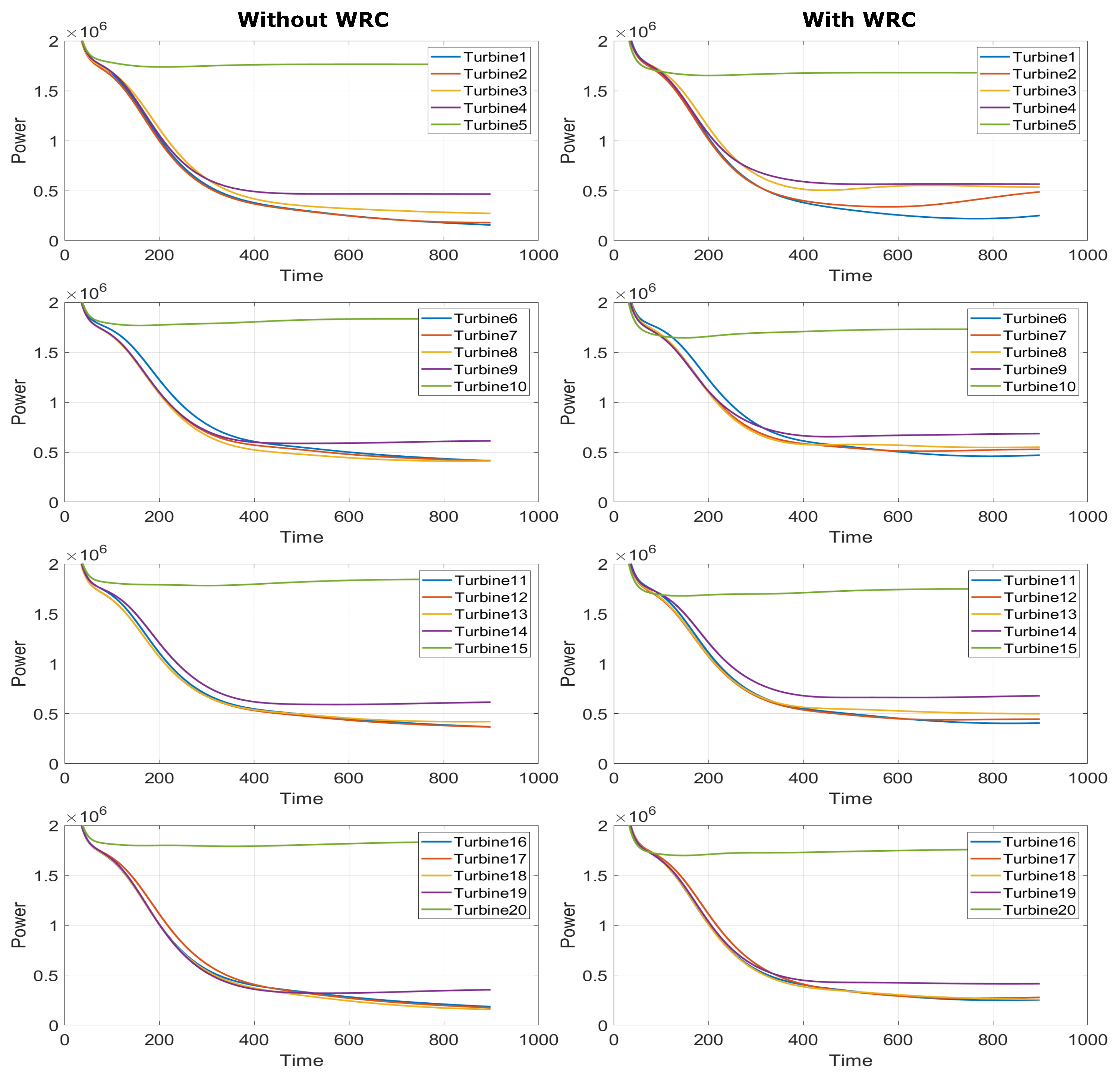
| Control Method | 3D | 4D | 5D | 6D |
|---|---|---|---|---|
| Without WRC | 1.7507 MW | 1.7504 MW | 1.7591 MW | 1.7589 MW |
| With WRC | 1.7605 MW | 1.7737 MW | 1.7920 MW | 1.8259 MW |
| Percentage Increase | 0.56% | 1.33% | 1.87% | 3.81% |
| Control Method | 7D | 8D | 9D | 10D |
| Without WRC | 1.7711 MW | 1.7730 MW | 1.7873 MW | 1.7979 MW |
| With WRC | 1.8488 MW | 1.8856 MW | 1.9101 MW | 1.9539 MW |
| Percentage Increase | 4.39% | 6.35% | 6.87% | 8.68% |
| Wind Speed—5 m/s | Farm Power | Wind Speed—6 m/s | Farm Power |
|---|---|---|---|
| Without Control | 7.2927 MW | Without Control | 12.602 MW |
| With WRC | 8.5491 MW | With WRC | 14.805 MW |
| With WRC-AIC | 8.5195 MW | With WRC-AIC | 14.784 MW |
| With AIC | 7.2917 MW | With AIC | 12.600 MW |
| Percentage Increase * | 17.2281% | Percentage Increase | 17.4813% |
| Wind Speed—7 m/s | Farm Power | Wind Speed—8 m/s | Farm Power |
| Without Control | 20.011 MW | Without Control | 29.871 MW |
| With WRC | 23.475 MW | With WRC | 34.993 MW |
| With WRC-AIC | 23.462 MW | With WRC-AIC | 34.997 MW |
| With AIC | 20.007 MW | With AIC | 29.866 MW |
| Percentage Increase | 17.3104% | Percentage Increase | 17.1470% |
Publisher’s Note: MDPI stays neutral with regard to jurisdictional claims in published maps and institutional affiliations. |
© 2022 by the authors. Licensee MDPI, Basel, Switzerland. This article is an open access article distributed under the terms and conditions of the Creative Commons Attribution (CC BY) license (https://creativecommons.org/licenses/by/4.0/).
Share and Cite
Balakrishnan, R.K.; Hur, S.-h. Maximization of the Power Production of an Offshore Wind Farm. Appl. Sci. 2022, 12, 4013. https://doi.org/10.3390/app12084013
Balakrishnan RK, Hur S-h. Maximization of the Power Production of an Offshore Wind Farm. Applied Sciences. 2022; 12(8):4013. https://doi.org/10.3390/app12084013
Chicago/Turabian StyleBalakrishnan, Raj Kiran, and Sung-ho Hur. 2022. "Maximization of the Power Production of an Offshore Wind Farm" Applied Sciences 12, no. 8: 4013. https://doi.org/10.3390/app12084013
APA StyleBalakrishnan, R. K., & Hur, S.-h. (2022). Maximization of the Power Production of an Offshore Wind Farm. Applied Sciences, 12(8), 4013. https://doi.org/10.3390/app12084013







